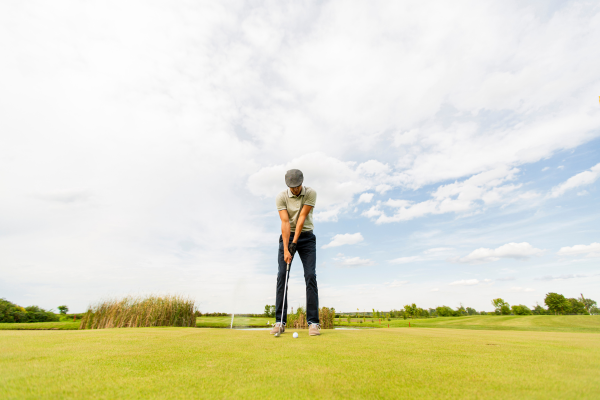You may think that a game of golf starts when the first player hits their first ball. However, this is simply not the case. If you watch the best players in the world, you will notice that they all have one thing in common – the pre-shot routine. ‘What is a pre-shot routine?’ we hear you ask. Don’t worry, we are here to break down exactly what a pre-shot routine is, why you need one and how to create one that works for you. Let’s dive in!
What is a pre-shot routine?
A pre-shot routine is a consistent procedure that is completed by a golfer before hitting each golf shot. It can include various different steps, such as specific thoughts, particular movements and significant details, that get the golfer ready and prepared to hit their ball. They are all different, and unique to each player. Whilst it may seem a bit strange at first, a pre-shot routine is one of the most acknowledged but underused mental game tips for golf, especially by amateur golfers and beginners.
Why do you need a pre-shot routine?
A pre-shot routine is a relatively easy thing to implement into your golf game in order to help you improve. The benefits are almost endless, it allows you to calm your nerves and grow your confidence in each shot, and – contrary to how it may feel – it is actually a great way of speeding up your game, as you tend to hit shots quicker and better.
The process of a pre-shot routine
Each pre-shot routine is slightly different, however they all seem to follow the same four main processes in order to focus more and play better.
The focus phase
The focus phase is possibly the most important. When playing a game of golf, you switch between having fun and chatting between shots, to seriously concentrating during a shot. You need a minute to focus, which you can do with something called a trigger.
A trigger is a step in your routine that you switch your brain back to concentration mode. A common trigger is velcroing your glove. By having this trigger point in mind, you know that as soon as this action has been completed, you need to assess and plan your shot.
The planning phase
The next step in the pre-shot routine is the planning phase. This phase is when you think about the shot you’re going to take. It’s important that you factor this in immediately after the trigger point, and not while you’re standing over the ball – as this is when your mind will need to be quiet.
The purpose of the planning phase is to pick the optimal shot, depending on the challenge ahead of you, such as the course layout and the weather conditions, and the risk reward of each option.
By thinking ahead with your shot planning, you will be feeling more confident about your type of shot and be ready to prime your mind and body to execute it.
The rehearsal phase
Step 3 of the pre-shot routine is the rehearsal phase, where you practise the shot you want to take. Your brain will move from the logical side to the creative side, and will prepare your subconscious to make a similar movement during your shot.
Instead of getting technical with the rehearsal phase, let your intention for the shot create your swing. This can be done in a number of different ways, such as focusing in on a very small target; visualising the ball flying across a shot tracer line; imagining the sound, rhythm and tempo of the shot; or verbalising what you want the ball to do.
Your brain will remember this a few seconds later when you come to take the shot, and you will feel confident that you’ve picked the best shot, rehearsed it and are committed to it!
The engagement phase
The final step in the process is the engagement phase. It is the period of time when you start to walk into the ball to when you start your backswing. The engagement phase will quiet your mind, keep distractions out, allow you to feel connected to the target and feel confident in your ability.
Once you’re in the engagement phase, thinking shouldn’t be needed. You don’t want any thoughts or noise interfering with your focus.
When should you use your pre-shot routine?
Though you should be completing your pre-shot before every shot, there will inevitably be times that you forget or don’t want to for whatever reason. It’s important to get comfortable with your pre-shot routine when you’re practising, before taking it into competition. This should make it easier to use when you need it the most.
There are probably two particular times that you will find it difficult to stick to your routine. Ironically, these are the times where it is most important:
- When you are playing poorly and allow your thoughts to go to techniques and general concern about your poor play.
- When you are playing extremely well, and feel that you don’t require it.
No matter the situation, ensure to always make your pre-shot routine a priority so that you can get the most from your game.
So there you have it, the four steps to take to nail your pre-shot routine. If you’re looking to upgrade your clubs alongside your pre-shot routine, Cash Fore Clubs are here to help. We have a range of new and second hand golf clubs to ensure you have the proper kit.
Contact Cash Fore Clubs or visit us today to find out how we can help you.


